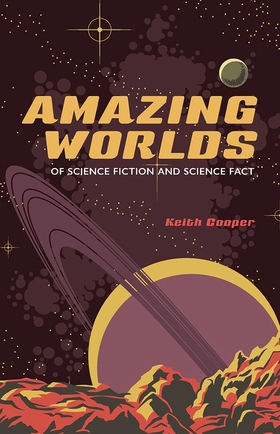Centauri Dreams
Imagining and Planning Interstellar Exploration
Up Close at Alpha Centauri
In early December the Harvard-Smithsonian Center for Astrophysics offered as part of its fall colloquium series a talk by Harvard’s Avi Loeb, fortunately captured on YouTube as Project Starshot: Visiting the Nearest Star Within Our Lifetime. We’ve looked at Breakthrough Starshot in many posts on Centauri Dreams, including my reports from the last set of meetings in Palo Alto, but for those new to the concept of using a laser array to send small, instrumented sails to the Alpha Centauri stars, this video is a fine introduction.
You’ll recall that yesterday I talked about Robert Austin’s futuristic Asteroid Belt Astronomical Telescope, with an illustration of what such an instrument might see of the exoplanet Gliese 832c. If Starshot can achieve its goals, it will be able to make out continent sized features on the surface of Proxima b, or perhaps a planet around Centauri A or B. It would achieve, in other words, what it would take a near-Earth space-based telescope 300 kilometers wide to equal.
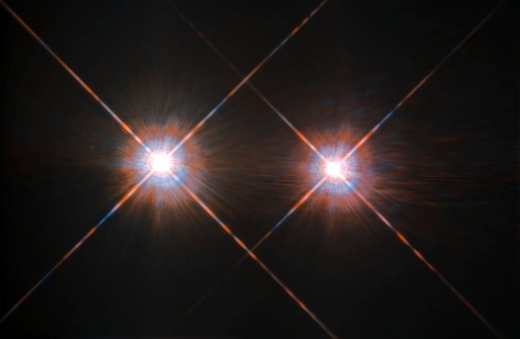
Image: What we can see today. The NASA/ESA Hubble Space Telescope has given us this stunning view of the bright Alpha Centauri A (on the left) and Alpha Centauri B (on the right), shining like huge cosmic headlamps in the dark. The image was captured by the Wide-Field and Planetary Camera 2 (WFPC2). WFPC2 was Hubble’s most used instrument for the first 13 years of the space telescope’s life, being replaced in 2009 by Wide-Field Camera 3 (WFC3) during Servicing Mission 4. This portrait of Alpha Centauri was produced by observations carried out at optical and near-infrared wavelengths. Credit: ESA/NASA.
Starshot envisions sending swarms of sails to its target stars, each moving at 20 percent of the speed of light. Each four-meter square lightsail would itself be used as the transmitter dish to beam data back to Earth showing us images of the planet, with each sail sending 100 images over the course of its observations. The time frames are interesting: If all goes without a hitch (and it’s hard to conceive of there being no hitches in a plan this ambitious), it will take several decades to build a beamer and create the actual sails and payload.
Then we have a launch, which takes place in a timeframe of minutes, as a mothership in a highly elliptical orbit releases a sail that is then under the beam for an intense 60,000 g ride. You can imagine all the stresses this puts on the sail, and again, we’ve talked about most of these in previous posts, but Avi Loeb’s presentation offers an excellent refresher, covering factors like sail stability under the beam, sail materials and interstellar dust encounters.
The launch phase ends in minutes and a 20 year cruise phase begins. In the Proxima Centauri system after the journey, each sail now faces an encounter time measured in hours. Thus the pattern: Hurry up and wait. For after the flyby, we face more time, a 4.24 year wait for the first images of the planet to come back to Earth. Interestingly, despite moving at relativistic speed, the planet’s image will remain circular thanks to so-called Terrell rotation.
Loeb mentions as a driver for investigation of Proxima Centauri in particular the fact that M-dwarfs make up a huge percentage of all the stars in the galaxy, and they can live for trillions of years. If we learn that life exists around this kind of star, we learn that living things will have incredibly long timeframes to continue to evolve. We also learn that the kind of environments found around red dwarfs are far more common than what we find around our own familiar G-class star. In many respects, we may wind up being the outliers.
Facets of the Journey
Yesterday I asked what effect being able to see images of planets like Proxima b from telescopes in our own Solar System would have on our thinking. Some would argue that we’ll reach the point where we can learn enough about exoplanets in such observations and will not need to build probes to other stars. My own view is that the two prospects work together. I think any images of a living, Earth-like world around a nearby star are going to focus interest in getting a payload into that system in order to make close up imagery and data possible.
On that score, you’ll recall Project Blue, the attempt to build a small space telescope explicitly designed to detect possible planets in the habitable zones around Centauri A and B (see Project Blue: Imaging Alpha Centauri Planets). Documentary filmmakers who are supporting Project Blue bring Debra Fischer (Yale University), one of its key players, into their new short video Traveling to Alpha Centauri? which explores the same terrain.
Although the video suggests antimatter rather than laser-beamed sails as a solution to the propulsion problem, Fischer’s comments go to the question of what the information we gain from our telescopes can motivate us to do.
If we discover an Earth-like planet orbiting Alpha Centauri, this is really going to drive a whole new era in science, an explosion, to finally go out into the galaxy and to start exploring other worlds.
Fischer goes on to speak of a ‘new wave within humanity to begin taking our steps out of our Solar System’ as a part of achieving the destiny of our species. I’m in agreement, and not just at the level of Project Blue. We could know within a decade or so about possible planets in the habitable zones of the two primary Centauri stars, and we may be able not long afterward to begin analyzing their atmospheres. I believe that hints of life on such worlds will ignite the imagination of the general public in support of projects to explore them up close. To me, Breakthrough Starshot and Project Blue, so different in their scale and conception, are nonetheless two sides of the same coin. An exploring species watches, learns and goes.

Thought Experiment: The Asteroid Belt Astronomical Telescope
Could laser light be used to shape and polish an asteroid to high optical standards? That’s the question raised in an imaginative essay in Physics Today that posits the creation, a century from now, of the Asteroid Belt Astronomical Telescope (ABAT). It’s science fiction today, part of the series of speculations that the magazine has been running to explore possible futures, but what a concept for an SF novel, and perhaps someday real astronomy (thanks to Centauri Dreams reader Klaus Seidensticker for sending me the link).
Author Robert Austin (Florida Polytechnic University) creates a backstory involving a “self-described over-the-hill assistant professor at Purdue University” who uses a research grant to polish a 1-centimeter sphere of pyrolytic carbon magnetically levitated in a vacuum. He achieves the needed flat optical surface along with a reflective hemispherical ‘bump’ on the object’s backside that can be used to reorient the mirror by photon pressure.
Soon the idea of using lasers to form and manipulate mirror components takes off, and by the end of the 21st Century an actual 2-meter asteroid is shaped and steered, using equipment originally developed for asteroid mining. The Asteroid Belt Astronomical Telescope that grows out of all this will eventually reach billions of mirror facets in imaging arrays in space, a 5 AU diameter astronomical mirror. Austin’s essay is written as a scientific report from the future, at a time 100 years from now when ABAT is 1% finished but already achieving stunning imagery.
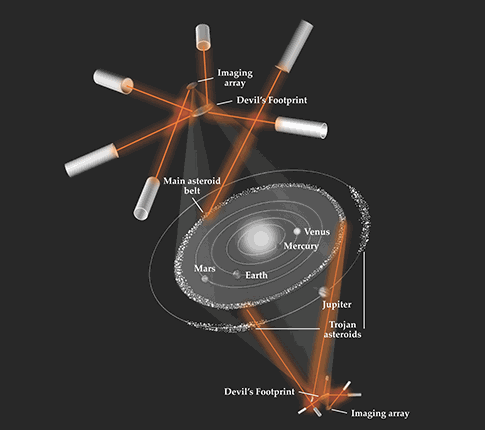
Image: The Asteroid Belt Astronomical Telescope (ABAT) focuses light from laser-polished asteroids onto dual imaging arrays above and below the solar system; other intense laser pulses maneuver the arrays to different locations, thus allowing ABAT to point at multiple celestial targets. Asteroid ablation residue corralled into a pair of Devil’s Footprints shields the focal regions from solar illumination. Credit: Robert Austin/Physics Today.
The ‘Devil’s Footprint’ reference in the caption above is to Munich’s Frauenkirche, which has a part of the floor in which no windows are visible — how it got its name is an entertaining part of the essay, which I’ll send you to for more. The point is that asteroid residue is a helpful way to block sunlight, and by the era depicted in this piece, asteroid mining is assumed to have become so widespread an activity that industrial operations at 5 AU are all but routine.
Bob Forward would, I’m sure, have loved the mega-engineering involved in creating something like this which, if built, would be the most ambitious scientific project ever undertaken. Austin’s ABAT would see its imaging arrays maneuvered through coordinated pulses of laser light, creating minuscule torques to turn each facet in the desired direction. As for enabling this vast cloud of technology to produce the needed data, here’s Austin’s take, based as is the whole article on the assumption of yet to be developed technologies:
Developing a conventional monolithic sensor array to span ABAT’s focal plane would be impractical, so Kim’s team hit upon a new approach based on diatoms, the microscopic organisms with silica skeletons that hold such a special place in the hearts of nanotechnologists. Group biologists genetically engineered diatoms to produce several specialized organs. Some of the organs convert light to electrical signals. Some store the microwave input power necessary for operating the array. Still others use CPS (celestial positioning system) signals to determine three-dimensional location, measure time, and digitally encode the data for transmission.
The result: Trillions of self-reproducing sensors are grown in a vat and deployed in space, manipulated as clouds of microscopic optical sensors.
Image readout begins when maser beams wake the sensors and provide transmission instructions. Guided by the electromagnetic field of the masers, the sensors align themselves toward a receiving antenna to which they beam their data. The vast data set is then relayed to ABAT’s brain, which puts the information together to form an image.
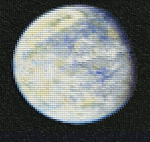
So there you have it, an array of 10 billion asteroids polished into mirror facets, all coordinated through artificial intelligence in a century-long project that might get underway, perhaps, by 2100. It’s a fascinating speculation, and I like the way Physics Today presents these explorations, in the form of articles you might read in the future issue that explains the project at hand. It makes for convincing reading, like good science fiction, and at times, I confess, it does make the hair stand up a bit on the back of the neck. Because imagine what we could see with something this vast, and imagine how much bigger still it could grow.
Image: Imaginary view. The exoplanet Gliese 832c as the future ABAT might see it early in the process of construction. Credit: Robert Austin/Physics Today.
If we ever do begin to see exoplanets at the level of detail promised in the artist’s rendering above, it’s worth speculating on what that might mean for interstellar exploration. Breakthrough Starshot puts the first interstellar crossing somewhere in the latter half of this century, assuming major breakthroughs in laser array technologies and engineering. Would a new ability to see exoplanets like this put a damper on future mission ideas, or would the view of prospective targets actually act as an incentive to get a payload into their systems?

Shifting Perspectives on Pluto’s ‘Heart’
One of the great pleasures of doing this site is watching researchers matching ideas in peer-reviewed papers. A paper can meet the highest standards for publication but still present an argument that subsequent researchers question, igniting a new round of debate. Trying to get at the heart of a scientific question requires patience, but it’s also as absorbing as a chess game, as witness the continuing debate over the history and significance of Pluto’s Sputnik Planitia. And in this case, we have a researcher working both sides of the controversy.
Resembling a polar ice cap, Sputnik Planitia is about 1000 kilometers across, and is centered on a latitude of 25 degrees north and a longitude of 175 degrees. Moreover, it is directly opposite the side of Pluto that always faces Charon, the result of tidal lock. Two weeks ago we looked at the possibility that this western lobe of Pluto’s ‘heart,’ a deep basin filled with frozen gases like nitrogen, carbon dioxide and methane, was the result of a relatively late impact, perhaps one as large as the impact that created Charon. The implications here were striking, particularly the possibility that Sputnik Planitia was a clue pointing to a subsurface ocean (see Pluto: Sputnik Planitia Gives Credence to Possible Ocean for references).
Today we look at a different possibility in a paper from Douglas Hamilton (University of Maryland), who worked with Francis Nimmo et al. on the subsurface ocean paper. The point is, there are dueling explanations here, and we need to examine them both along with any other potential candidates to explain Sputnik Planitia. After all, it’s a huge feature, and we find ice caps on only three worlds in our Solar System, making its formation a matter of interest whether or not its presence actually indicates an ocean beneath the ice.
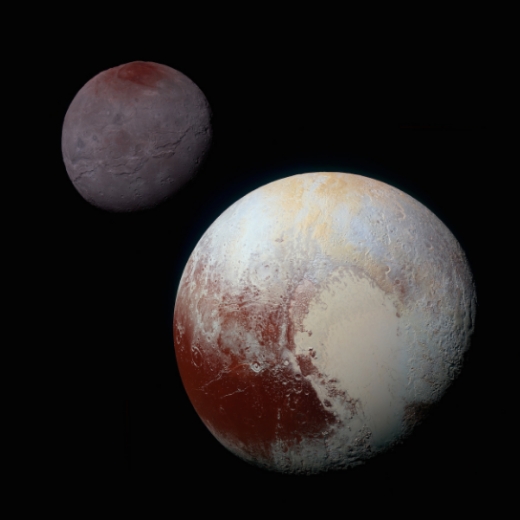
Image: Pluto, shown here in the front of this false-color image, has a bright ice-covered ‘heart.’ The left, roughly oval lobe is the basin provisionally named Sputnik Planitia. Sputnik Planitia appears directly opposite Pluto’s moon Charon (back). Credit: NASA/JHUAPL/SWRI.
The model Hamilton studies in this paper is one in which there is no impact, and the ice cap actually formed early in Pluto’s development, providing the surface asymmetry that eventually causes the ice cap to become locked on the side of the world opposite Charon. Remember that Pluto’s spin axis is tilted to 120 degrees. Ice would form in the coldest places on the planet, which in Pluto’s case are latitudes 30 degrees north and south. Temperatures here are far colder than either pole, a zone that includes latitude 25-degree north Sputnik Planitia.
Hamilton and colleagues see a runaway albedo effect as a possibility here, a positive feedback mechanism that begins with a small ice deposit and accumulates more and more ices until a dominant ice cap emerges. It is the gradual shift in the dwarf planet’s mass, then, that came into play to ensure that Sputnik Planitia would, as Pluto slowed due to Charon’s gravity, either face Charon or emerge on the opposite side of the world from its moon. The chances are 50-50, as Hamilton notes: “It is like a Vegas slot machine with just two states, and Sputnik Planitia ended up in the latter position, centered at 175 degrees longitude.”
So there we have it, a new possibility in which Sputnik Planitia formed not through an impact, but through the weight of accumulating surface ices. The formation of a basin like this one is not so different from what we see on Earth in the Greenland Ice Sheet, where a basin forms and pushes down on the crust beneath it, although Hamilton adds that Pluto’s basin is larger than the volume of ice it currently contains, evidence that Sputnik Planitia is losing mass over time. Either formation model fits the New Horizons data, leaving us with an inconclusive result about that putative ocean. Under the right conditions, says Hamilton, either model is viable.
The paper is Hamilton et al., “The rapid formation of Sputnik Planitia early in Pluto’s history,” Nature 540 (01 December 2016), 97-99 (abstract).

Visualizing the Alien: A Hollywood Conundrum
Aliens used to look more or less like humans in the films of the 1950s. Think Michael Rennie in The Day the Earth Stood Still (1951), a polished alien presence if there ever was one. We got humanoid aliens with strange powers or technologies, like Jeff Morrow playing Exeter in This Island Earth (1955) — a prominent forehead and strange hair is all it takes. Even James Arness’ vegetable man (The Thing from Another World, 1951), although seen but briefly and on a rampage, is recognizably humanoid.

Image: James Arness makes his appearance in Howard Hawks’ The Thing from Another World.
I watched all those films and many other SF movies besides when I was growing up, almost all on TV re-runs. Later, special effects would vastly improve, and non-humanoid aliens thrived, my favorite being the repulsive title character in Ridley Scott’s Alien (1979), so dramatically visualized by Swiss surrealist Hans Rudolf Giger. Now we see aliens in all shapes and sizes, from the many-toothed predator that causes problems for the local (all too humanoid) beings in James Cameron’s Avatar (2009) to the shape-changing monstrosity of John Carpenter’s 1982 version of The Thing.
Science writer Leslie Mullen has a nice piece on Hollywood depictions of aliens whose title carries the punch: We’re Still Waiting for Hollywood to Depict a Plausible Alien Ecosystem. Interestingly, one of the big problems that the scientists she interviewed see in Hollywood is that its aliens seem to have no constraints on their growth. I hadn’t even noticed this, but of course it’s true: The creature in the original Alien pops out of John Hurt’s chest (a memorable scene indeed) and almost immediately begins to grow.
But how? Mullen quotes biochemist Jim Cleaves (Institute for Advanced Study) on the matter:
“The alien always bothered me. Somehow it manages to turn a few pounds of biomass into several hundred pounds of really hyperactive alien really quickly, without actually eating anything.”
Nutritional issues are a common theme in critiques voiced in this piece by Cleaves and Caleb Scharf (Columbia University), who has his own bone to pick with Avatar:
“There’s a creature with lots of teeth. It’s cool. But whenever you invoke such a monstrous thing, you have to ask, Could this ecosystem really support that? We had dinosaurs at one point, but there were a lot of them, and an enormous food pyramid to support that. So you wouldn’t have a quiet forest except for one enormous monster. What are they eating?”
And how about the enemy ‘bugs’ in Paul Verhoeven’s Starship Troopers (1997)? What exactly did they do to stay alive?
Plugging in a monster moves a plot right along, of course, but if that’s all it’s doing, the plot is neglecting to examine how a real biosphere would work. That would be a sensationally complex task, but given the amount of research now going on in astrobiology and exoplanetary science, the suspicion here is that experts could be summoned who could produce such a film. Even so, there is something to be said for not seeing aliens.
Think 2001: A Space Odyssey, where we see artifacts rather than beings, a fact which lets the viewer’s imagination speculate on what the builders of the monoliths might have been like. Or think about Arkady and Boris Strugatsky’s 1971 novel Roadside Picnic. Andrei Tarkovsky’s film Stalker (1979) grew out of this, with screenplay by the authors. Here we see the aftermath of an extraterrestrial visitation that took place simultaneously at locations around the world. No aliens are seen, but the six Visitation Zones are scattered with odd, incomprehensible artifacts. An illegal smuggling trade in these artifacts emerges. But just who were these aliens, what was their purpose, and did they even notice the fact that they were, briefly, in the midst of an active technological civilization?

Image: No aliens here, which actually gives Stalker its force. What to make of an incomprehensible technology’s detritus?
Mullen’s essay quotes Penny Boston (NASA Astrobiology Institute) on a form of life that may challenge Hollywood’s best special effects crews. Robert Forward’s novel Dragon’s Egg (1980) depicts life on a neutron star with a surface gravity 67 billion times that of the Earth. Here we find the Cheela, which are tiny creatures whose civilization advances a million times faster than our own, as observed by humans in an orbiting craft.
How screenwriters would handle scenes on a neutron star is an open question, but each new movie gives us the opportunity to watch another treatment of an issue that has gone from Hollywood trope to serious speculation in a few short decades. Think about this as you evaluate the aliens in Denis Villeneuve’s new film Arrival, and ponder the directions evolution might take given billions of possible worlds on which to work its magic.
Even back in the days of the original Star Trek, as Caleb Scharf notes in Mullen’s essay, writers dreamed up the Horta (the episode was “The Devil in the Dark”), who look like nothing more than rocks. It takes the crew a while to realize they are intelligent. I’m reminded of something Jacob Bronowski said in his TV series The Ascent of Man (1973):
Within the last few years there have been found in the interstellar spaces the spectral traces of molecules which we never thought could be formed out in those frigid regions: hydrogen cyanide, cyanoacetylene, formaldehyde. These are molecules which we had not supposed to exist elsewhere than on Earth. It may turn out that life had more varied beginnings and has more varied forms. And it does not at all follow that the evolutionary path which life (if we discover it) took elsewhere must resemble ours. It does not even follow that we shall recognise it as life — or that it will recognise us.”

Tight Constraints on Orbit of a Transiting ‘Super-Earth’
The super-Earth K2-3d orbits a red dwarf star in the constellation Leo, some 150 light years from Earth. The outermost of three planets discovered in the system, K2-3d was found in the K2 phase of the Kepler mission (K2 Second Light), following the issues with the spacecraft’s reaction wheels that led to the end of the primary mission. Interestingly, while the planet is large (with a radius 1.5 times that of Earth), its density is high and indicative of a solid surface (we can measure the radius of K2-3d by studying the transit light curve, while radial velocity methods yield the planet’s mass, allowing astronomers to calculate its density).
Given the right atmospheric parameters, liquid water could exist here, although most models show a tidally locked world receiving too much solar flux (1.4 times that of the Earth) to make habitable conditions likely. With an orbital period of 45 days, K2-3d’s transits are interesting because the planet is close enough to be a useful candidate for follow-up study with next generation telescopes. Transmission spectroscopy will allow us to study its atmosphere as starlight filters through it during a transit, opening up the possibility of searching for potential biosignatures.
But transits have to be observed to make such studies, and that means we must refine the transit ephemeris, which gives us needed parameters about when the planet will cross the face of its star as seen from Earth. The problem here is that we originally had only two transits to work with because the K2 mission surveys each area of the sky for a limited period of time. But an additional two transits were added soon after the planet’s discovery using data from the Spitzer Space Telescope, yielding a total of four measurements.
Now a team from the National Astronomical Observatory of Japan (NAOJ) and the University of Tokyo has used the MuSCAT (Multi-color Simultaneous Camera for studying Atmospheres of Transiting planets) instrument on the Okayama Astrophysical Observatory’s 188-cm telescope to produce the first transit data on K2-3d from a ground-based telescope. This fifth transit has refined the orbital period of K2-3d to within about 18 seconds, setting up future transit observations of a world on the inner edge of its star’s habitable zone.
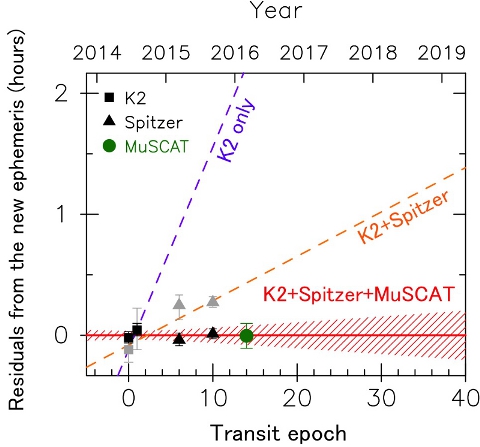
Image: Predicted transit time deviation from the improved K2-3d transit ephemeris based on this research. The solid red line indicates the predicted times based on this research, the shaded area shows the uncertainty range. Squares, triangles, and circles are respectively the transit time data from the Kepler Telescope, Spitzer Space Telescope, and the latest observing instrument MuSCAT on the Okayama 188-cm Reflector Telescope. Gray marks show the values calculated in previous research and black marks represent the values re-calculated in this research. Purple and orange dotted lines are the transit ephemerides calculated in previous research using the K2 and the K2+Spitzer data, respectively. This research succeeded in correcting the predictions for the 2018 transit times by more than an hour. (credit: NAOJ).
The decrease in brightness of the host star as K2-3d transits is small, but the next generation of large telescopes should have plenty to work with. From the paper:
The transit depth of K2-3d is the second shallowest among those observed by ground-based telescopes, following 55 Cnc e (0.4 mmag transit observed by the 2.5m Nordic Optical Telescope, de Mooij et al. 2014). Our observation demonstrates that ground-based photometric observations can play an important role in improving the transit ephemeris of small-sized, long-period planets, including potentially habitable ones, discovered by ongoing and future space-based transit surveys such as K2 and the Transiting Exoplanet Survey Satellite (Ricker et al. 2015), whose survey durations are limited.
K2-3d will not be the last transiting planet discovered by K2, which continues its mission until at least February of 2018, and as the paper notes, we can look forward to the Transiting Exoplanet Survey Satellite (TESS), scheduled for launch in December of 2017. While K2-3d is a useful addition to the catalog, we will likely find numerous small planets even closer for follow-up studies of their atmosphere. Ground-based observations to measure the ephemerides of transiting planets will be crucial as we bulk up our catalog of nearby worlds.
The paper is Fukui et al., “Ground-based Transit Observation of the Habitable-zone Super-Earth K2-3d,” Astronomical Journal 21 November 2016 (abstract / preprint).

Saturn: ‘Grazing’ the Rings
What the Jet Propulsion Laboratory refers to as ‘the first phase of the mission’s dramatic endgame’ begins tomorrow for the Cassini Saturn orbiter. Having given us an ocean within Enceladus and numerous images of Titan’s lakes and seas (not to mention ring imagery of spectacular beauty), Cassini now enters a phase in which it encounters the rings in a new way, diving past their outer edge every seven days in a series of 20 passes. The spacecraft will be in an elliptical orbit inclined some 60 degrees from the planet’s ring plane.
“We’re calling this phase of the mission Cassini’s Ring-Grazing Orbits, because we’ll be skimming past the outer edge of the rings,” said Linda Spilker, Cassini project scientist (JPL). “In addition, we have two instruments that can sample particles and gases as we cross the ring plane, so in a sense Cassini is also ‘grazing’ on the rings.”
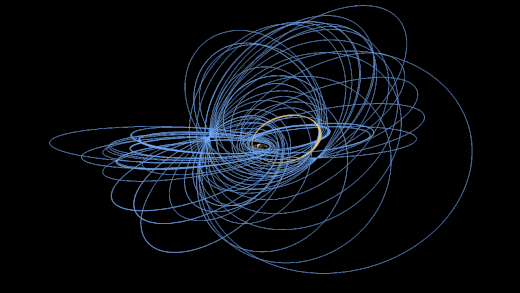
Image: Cassini crosses Saturn’s F ring once on each of its 20 Ring-Grazing Orbits, shown here in tan and lasting from late November 2016 to April 2017. Blue represents the extended solstice mission orbits, which precede the ring-grazing phase. Credit: JPL.
That grazing will include two passes directly through a tenuous ring created by meteor strikes on the small moons Janus and Epimetheus. Each orbit will cross the ring plane just outside the F ring, considered to be the boundary of the main ring system, with Cassini actually moving through the outer edges of the F ring in April. Here the science should be particularly interesting — the 800-kilometer wide F ring is malleable, developing and dispersing filament-like structures, dark channels and streamers over short periods of time.
“Even though we’re flying closer to the F ring than we ever have, we’ll still be more than 4,850 miles (7,800 kilometers) distant. There’s very little concern over dust hazard at that range,” said Earl Maize, Cassini project manager at JPL.
A gravity assist by Titan on the T-125 flyby put the craft into its ring-grazing orbits. The new orbits (‘revs’ or revolutions in JPL parlance) begin when the spacecraft is at apoapse, its most distant position from Saturn, and the ring plane crossings happen when Cassini is at periapse, its closest approach to the planet during that orbit. The first ring-grazing orbit beginning on November 30 will see the ring plane crossing 5 days later. A final Titan flyby (T-126) in April sets up the last phase of the orbiter’s mission.
The new orbital configuration will allow Cassini to make close studies of the A and B rings as well as the F at a high level of detail. The A ring’s so-called ‘propellers’ — features that mark the location of tiny moonlets — should be seen in the best detail yet, offering researchers the chance to examine their structure. We’ll begin to see images from this phase of the mission in December as the spacecraft resolves details smaller than 1 kilometer per pixel.
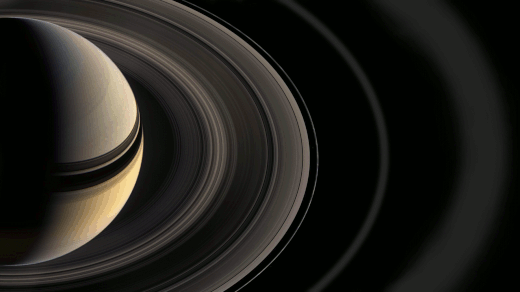
Image: Saturn’s rings were named alphabetically in the order they were discovered. The narrow F ring marks the outer boundary of the main ring system. Credit: NASA/JPL-Caltech/Space Science Institute.
The distances involved in this phase of the mission are worth noting. The new orbits will take the craft within 90,000 kilometers of the planet’s cloud tops, but the Grand Finale phase, scheduled to begin next April, closes to within 1628 kilometers. This should be breathtaking, for the craft will move again and again through the gap between Saturn and the rings before making its final plunge into the atmosphere on September 15. Preparations for this final phase begin with a main engine burn on December 4. This is an engine that has served us well — this will be its 183rd burn — but the remainder of the mission will be handled with thrusters.
The spacecraft will be making a nine-hour movie of Saturn’s north pole with its Visual and Infrared Mapping Spectrometer, while also measuring (with other instruments) the boundaries of the planet’s upper atmosphere, which will be directly sampled in later orbits. You can find a complete list of Cassini’s ring-grazing orbits on this JPL reference page. Bear in mind as you look at it that there is a wonderful symmetry here. The level of detail we’ll see on these final orbits will be rivaled only by what Cassini saw upon its arrival at Saturn in 2004.

